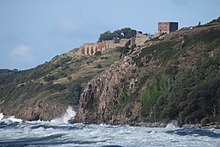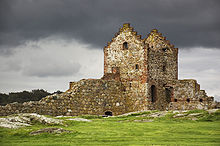Hammershus
| Hammershus Castle | ||
|---|---|---|
|
Hammershus castle ruins |
||
| Castle type : | Hilltop castle | |
| Conservation status: | ruin | |
| Place: | Bornholm Island | |
| Geographical location | 55 ° 16 '15.5 " N , 14 ° 45' 18" E | |
|
|
||
Hammershus [ hɑməʀsˈhuːʔs ] was a heavily fortified castle on the northwest side of the Danish island of Bornholm . Today it is one of the largest connected castle ruin complexes in Northern Europe. It lies on a cliff 74 meters above sea level and is surrounded by a 750-meter-long curtain wall. Since the transfer of Skåne from Denmark to Sweden in the 17th century, it is Germany and Sweden closer than the rest of Denmark.
history

Hammershus was built during the 13th century and was mainly owned by the Archbishops of Lund until the 16th century . During the battles between the archbishops and the Danish kings for supremacy on Bornholm, the castle passed to the latter several times, for example in 1259, 1265, 1319 and 1325. In 1521, it came into the possession of Christian II , who was Bishop Jens Andersen here Beldenak held captive. In the same year the castle was conquered by the Lübeck Hanseatic League .
In the battles between Christian II and his successor Frederik I , Frederik received support from a Lübeck fleet and, as compensation, had to pledge Bornholm to Lübeck for 50 years in 1525. During this time Hammershus was the seat of the Lübeck bailiffs and was developed into the largest castle complex in Northern Europe , especially under the Lübeck bailiff Bernt Knop (1525–1543). The last Lübeck bailiff on Bornholm was councilor Mattheus Tidemann from 1573 until the island was returned . When the pledge expired in 1575, Bornholm became a fiefdom of the Danish crown. The feudal man had the castle as his residence, but also had to keep it. As a result, the castle slowly fell into disrepair; the feudal men preferred to live in Rønne or one of the island's large farms.
In 1658 Hammershus was briefly occupied by Swedes, but after an uprising by the Bornholm population, they had to leave the castle again. Between 1660 and 1661 Leonora Christina , the daughter of the Danish King Christian IV , was imprisoned in Hammershus with her husband, the traitor Corfitz Ulfeldt . Even later, the castle often served as a state prison.
In 1743 the castle was abandoned. As a result, parts of the complex were demolished for the extraction of building materials until the ruin was listed as a historical monument by royal decree in 1822. The first conservation measures began in 1890 and have continued to this day with interruptions. The ruin is now a popular tourist destination.
construction
The facility consists of an inner courtyard and two outer courtyards. The fortress is dominated by a huge, rectangular donjon . The inner courtyard could be reached through a square gate tower. It is protected by a nine meter high curtain wall with side towers. The individual buildings leaned against the inner wall of the wall. A watchtower and a small ravine prevented an unnoticed approach.
literature
- Chris Gravett: Atlas of Castles. The most beautiful castles and palaces ("Castles", 1999). Tosa, Vienna 2001, ISBN 3-85492-470-4 , p. 133.
See also
List of castles, chateaus and fortresses in Denmark
Web links
Individual evidence
- ↑ Hammershus , in: bornholm.info, accessed on March 14, 2020.
- ^ Antjekathrin Graßmann (ed.): Lübeckische Geschichte. 2nd edition Verlag Schmid-Römhild, Lübeck 1989, ISBN 3-7950-3203-2 , p. 376 ff.
- ↑ Nordbornholm and Hammershus , accessed March 14, 2020.






